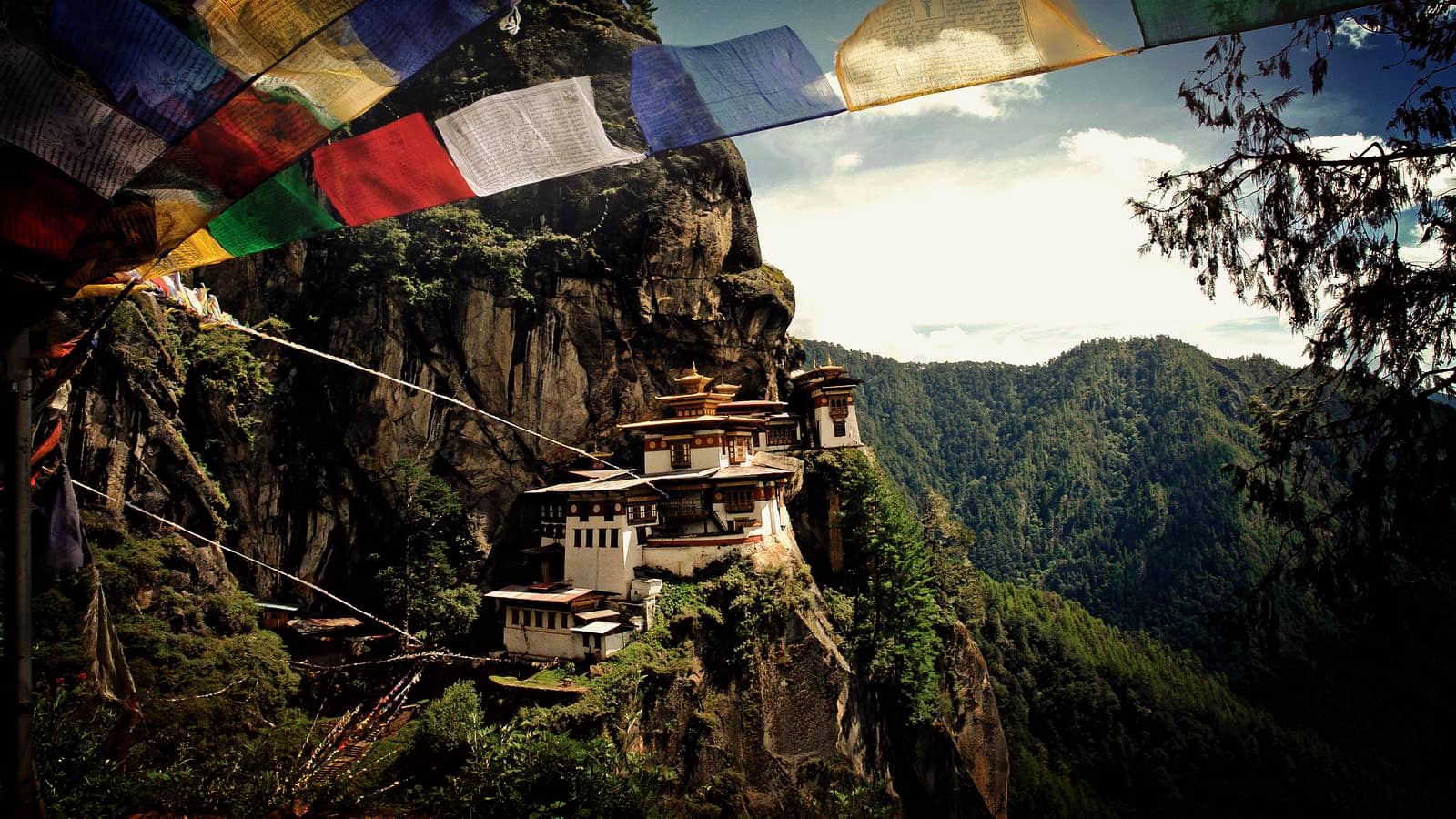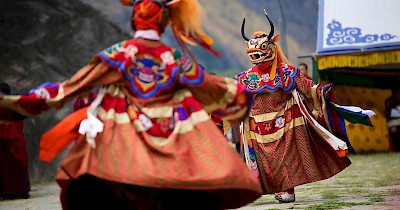About Bhutan
Bhutan is no ordinary place. It is a Himalayan kingdom with a reputation for mystery and magic, where a traditional Buddhist culture carefully embraces global developments.
Why you will love Bhutan!
As a former conservation biologist, for me there's lots to love about Bhutan. The mountains are carpeted in diverse forests that sing with birds, and it's the opportunity to explore this relatively untouched corner of the Himalaya that keeps me coming back. A highlight of my recent trip was a pair of rufous-necked hornbills feeding right beside the road. Bhutan's Buddhist tradition of respect and reverence for nature plus its amazing festivals and engaging people are the headlines to a rewarding and complex story about a beautiful Himalayan kingdom with a unique outlook on progress.
Environmental Credentials
When you visit Bhutan, you will become one of the few who have experienced the natural charm of the first country where Gross National Happiness is deemed more important than Gross National Product. By law, at least 60% of the country must remain forested for all future generations. You will experience Bhutan's natural wonders first-hand when travelling the mountain passes – resplendent with rhododendron blossom in spring. Botanical riches and unique mammals and birds are protected in several national parks, and a mountain trek is one of the best ways to experience the Himalaya.
Surprising Bhutan
Bhutan holds many surprises. This is a country where the rice is red and where chillies aren't just a seasoning but the main ingredient. It's also a deeply Buddhist land, where monasteries are part of the mainstream, and where giant protective penises are painted beside the entrance to many houses. While it visibly maintains its Buddhist traditions, Bhutan is not a museum. You will find the Bhutanese well educated, fun loving and vibrant.
Low Volume, High Value Tourism
The Bhutanese pride themselves on a sustainable approach to tourism in line with the philosophy of Gross National Happiness. Firstly, to bust a myth: there is no limit to tourist visas. Visitors famously pay a minimum tariff of US$250 per day, making it appear as one of the world's more expensive destinations. However, this fee is all-inclusive – accommodation, food, transport and an official guide are all provided. You don't have to travel in a large group and you can arrange your own itinerary. What you won't find is backpacker-style travel.
The Last Shangri La?
So why spend your money to come here? Firstly there is the amazing Himalayan landscape, where snowcapped peaks rise above shadowy gorges cloaked in primeval forests. Taking up prime positions in this picture-book landscape are the majestic fortress-like dzongs and monasteries. This unique architecture embodies Buddhist culture and sets the scene for spectacular tsechus (dance festivals). Then there are the textiles and handicrafts, outrageous archery competitions, high-altitude trekking trails, and stunning flora and fauna. If it's not 'Shangri La', it's as close as it gets.
Source: Lonely Planet, written by Lindsay Brown
Bhutan, officially the Kingdom of Bhutan, is a landlocked country in South Asia at the eastern end of the Himalayas. Bhutan borders China to the north and India to the south, east and west. To the west, it is separated from Nepal by the Indian state of Sikkim; farther south it is separated from Bangladesh by the Indian states of Assam and West Bengal. Bhutan's capital and largest city is Thimphu.
Bhutan existed as a patchwork of minor warring fiefs until the early 17th century. At that time the lama and military leader Ngawang Namgyal, the first Zhabdrung Rinpoche, who was fleeing religious persecution in Tibet, unified the area and cultivated a distinct Bhutanese identity. In the early 20th century, Bhutan came into contact with the British Empire and retained strong bilateral relations with India upon its independence. In 2006, based on a global survey, Business Week rated Bhutan the happiest country in Asia and the eighth-happiest in the world. In 2016, the World Happiness Report published by the United Nations ranks Bhutan as the 84th happiest country.
Bhutan's landscape ranges from subtropical plains in the south to the sub-alpine Himalayan heights in the north, where some peaks exceed 7,000 metres (23,000 ft). Its total area was reported as approximately 46,500 km2 (18,000 sq mi) in 1997 and 38,394 km2 (14,824 sq mi) in 2002. Bhutan's state religion is Vajrayana Buddhism and the population, as of 2015 estimated as 770 thousand people, is predominantly Buddhist. Hinduism is the second-largest religion.
In 2008, Bhutan made the transition from absolute monarchy to constitutional monarchy and held its first general election. As well as being a member of the United Nations, Bhutan is a member of the South Asian Association for Regional Cooperation (SAARC) and hosted SAARC's sixteenth summit in April 2010.
Geography of Bhutan
Bhutan is located on the southern slopes of the eastern Himalayas, landlocked between the Tibet Autonomous Region to the north and the Indian states of Sikkim, West Bengal, Assam and Arunachal Pradesh to the west and south. It lies between latitudes 26°N and 29°N, and longitudes 88°E and 93°E. The land consists mostly of steep and high mountains crisscrossed by a network of swift rivers, which form deep valleys before draining into the Indian plains. Elevation rises from 200 m (660 ft) in the southern foothills to more than 7,000 m (23,000 ft). This great geographical diversity combined with equally diverse climate conditions contributes to Bhutan's outstanding range of biodiversity and ecosystems.
The northern region of Bhutan consists of an arc of Eastern Himalayan alpine shrub and meadows reaching up to glaciated mountain peaks with an extremely cold climate at the highest elevations. Most peaks in the north are over 7,000 m (23,000 ft) above sea level; the highest point in Bhutan is Gangkhar Puensum at 7,570 metres (24,840 ft), which has the distinction of being the highest unclimbed mountain in the world.[42] The lowest point, at 98 m (322 ft), is in the valley of Drangme Chhu, where the river crosses the border with India.[42] Watered by snow-fed rivers, alpine valleys in this region provide pasture for livestock, tended by a sparse population of migratory shepherds.
The Black Mountains in the central region of Bhutan form a watershed between two major river systems: the Mo Chhu and the Drangme Chhu. Peaks in the Black Mountains range between 1,500 and 4,925 m (4,921 and 16,158 ft) above sea level, and fast-flowing rivers have carved out deep gorges in the lower mountain areas. The forests of the central Bhutan mountains consist of Eastern Himalayan subalpine conifer forests in higher elevations and Eastern Himalayan broadleaf forests in lower elevations. Woodlands of the central region provide most of Bhutan's forest production. The Torsa, Raidak, Sankosh, and Manas are the main rivers of Bhutan, flowing through this region. Most of the population lives in the central highlands.
In the south, the Shiwalik Hills are covered with dense Himalayan subtropical broadleaf forests, alluvial lowland river valleys, and mountains up to around 1,500 m (4,900 ft) above sea level. The foothills descend into the subtropical Duars Plain. Most of the Duars is located in India, although a 10 to 15 km (6.2 to 9.3 mi) wide strip extends into Bhutan. The Bhutan Duars is divided into two parts: the northern and the southern Duars.
The northern Duars, which abut the Himalayan foothills, have rugged, sloping terrain and dry, porous soil with dense vegetation and abundant wildlife. The southern Duars has moderately fertile soil, heavy savannah grass, dense, mixed jungle, and freshwater springs. Mountain rivers, fed by either the melting snow or the monsoon rains, empty into the Brahmaputra River in India. Data released by the Ministry of Agriculture showed that the country had a forest cover of 64% as of October 2005.
Climate of Bhutan
The climate in Bhutan varies with elevation, from subtropical in the south to temperate in the highlands and polar-type climate, with year-round snow in the north. Bhutan experiences five distinct seasons: summer, monsoon, autumn, winter and spring. Western Bhutan has the heavier monsoon rains; southern Bhutan has hot humid summers and cool winters; central and eastern Bhutan is temperate and drier than the west with warm summers and cool winters.
Source: Wikipedia



